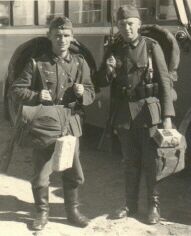Research projects ❘ Postal Censorship ❘ Bibliography❘
The Collection ❘ Database ❘ Selected Letters ❘ War letters as love letters ❘ Contact Us❘
|
Start ❘
German War Letters ❘
Links❘ Research projects ❘ Postal Censorship ❘ Bibliography❘ The Collection ❘ Database ❘ Selected Letters ❘ War letters as love letters ❘ Contact Us❘ |
» Deutsche Version |
 During the Second World War 30-40 billion letters, postcards and parcels were sent between the front and home and it is assumed that even more letters must have been mailed. During the Franco-Prussian War in 1870/71 (France against Germany) 101 million letters were sent, and during the First World War the numbers reached 28.7 billion. This huge amount of data material from the Second World War provides a useful source for science. Therefore it is important to conduct research on the available material. In Germany alone some thousand letters rest in archives and are held by collectors. There is no systematic access to the data at present. Documents that remain in private households should be made available for scientific research where possible and the owners are willing to support.
During the Second World War 30-40 billion letters, postcards and parcels were sent between the front and home and it is assumed that even more letters must have been mailed. During the Franco-Prussian War in 1870/71 (France against Germany) 101 million letters were sent, and during the First World War the numbers reached 28.7 billion. This huge amount of data material from the Second World War provides a useful source for science. Therefore it is important to conduct research on the available material. In Germany alone some thousand letters rest in archives and are held by collectors. There is no systematic access to the data at present. Documents that remain in private households should be made available for scientific research where possible and the owners are willing to support.
War letters provide evidence of personal experiences, display the writers' minds, inform us about their knowledge of the war and give us an idea of the self-image of the chronicler. Information the writers give knowledge is often contrary to the real historical facts. Many letters have an ambivalent tone which lies in the function of the letters: these letters were meant to be a sign of life and a farewell letter at the same time. Regardless of the content of the letter, they are documents that provide eye-witness accounts of events with a high degree of authenticity, uninfluenced by today's knowledge about the war and freed from the problems of memory. By nature they completely lack any sort of retrospective tone, but rather come to us as original and genuine voices of a time whose dimension of radicalism has been to date only incompletely analyzed. In addition their linguistic form of expression and the choice of words reflect the zeitgeist of the war generation.
Why are these letters so interesting for research? They represent the subjective reality of the war. They provide evidence of primarily personal experiences of the war. Mostly the soldiers were not informed about military strategies. This in mind the question raised by Fritz Stern (winner of the prize of peace of the German book trade) with the remark that it would never come under the statute of limitations: "How was it possible?" must be asked.
Does "propaganda" work? If it does, how and under what conditions? How could it come to an unleashing of brutality and apparent legitimization of cruel violence? How is violence to be seen in view of collective fear and collective delusion? Recruits were sent to the front without adequate training. Their life expectancy at the eastern front amounted to two weeks up to three months. In the end we can finally get to know the men who are summarized with the word "German Wehrmacht" through their letters.
War letters give us an impression of the people at the "Heimatfront". Air attacks, life on food ration cards, uncertainty about the whereabouts of fathers, sons, brothers and husbands as well as mothers, daughters, sisters and wives and the liability of work were tremendous burdens for the families who were torn apart.
Letters from camps, jails, forced labor camps and war prisons let us know about the "rules of war".